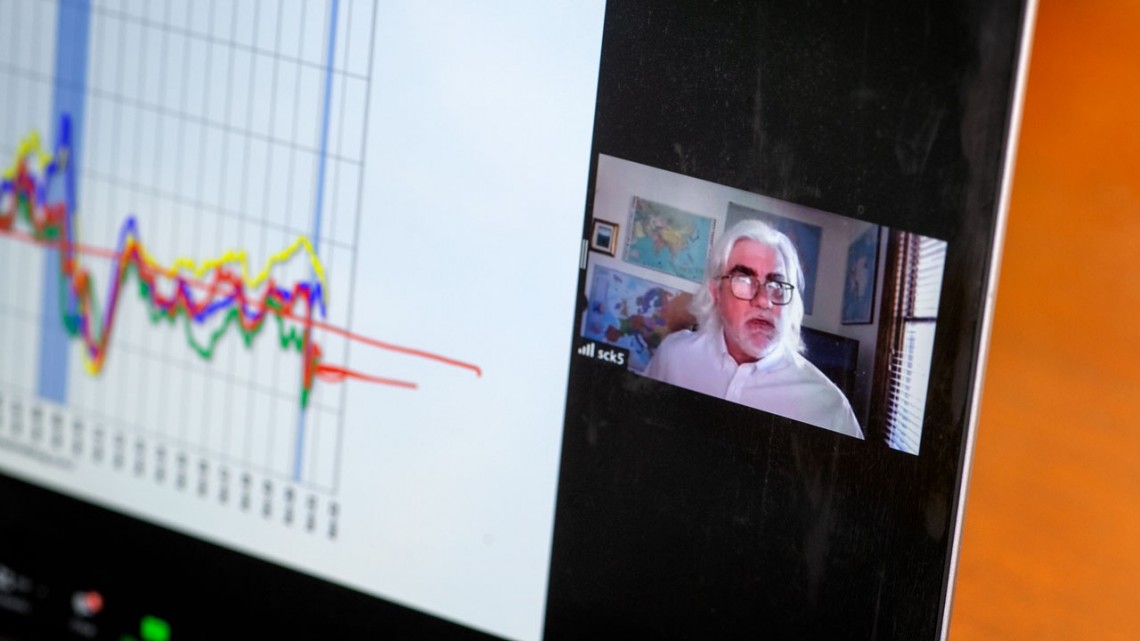
Steven Kyle, associate professor in the Charles H. Dyson School of Applied Economics and Management, presenting his annual forecast for the U.S. economy during Dyson’s 2021 Agricultural and Food Business Outlook Conference, held virtually Jan. 25.
Economist: U.S. poised for rebound with vaccines, stimulus
By James Dean
Look for the U.S. economy to bounce back in 2021 from its most severe challenges since the Great Depression, a recovery that would benefit from continued federal relief and stimulus spending, according to a Cornell economist.
“(This year) is going to be so much better than 2020,” said Steven Kyle, associate professor in the Charles H. Dyson School of Applied Economics and Management, part of the Cornell SC Johnson College of Business. “You will think you’re in a different universe.”
Kyle presented his annual projection for the national economy at Dyson’s 2021 Agricultural and Food Business Outlook Conference, held virtually Jan. 25. The conference also featured presentations on New York’s farm workforce and markets for dairy, fruit, vegetables and wine.
A year ago, Kyle predicted that an extended period of U.S. growth would peak in 2020, starting a downturn that had the potential to influence the presidential election.
There was a downturn – albeit for reasons no one saw coming.
“Who could predict that a virus would happen and everything would fall apart?” Kyle said at the outset of his talk, titled “Virus Economics.”
U.S. maps showing state-level indexes of economic activity illustrated the abrupt impact of lockdowns imposed last spring to “flatten the curve” of coronavirus infections. The Federal Reserve Bank of Philadelphia’s map last February was mostly green, indicating positive activity in all but one state. But by April, the entire nation was awash in red, reflecting the “deep, deep slowdown” across the country, Kyle said.
By June, unemployment had rocketed to nearly 15%, according to the U.S. Bureau of Labor Statistics, and as high as 20% by some broader measures.
The situation more resembled a natural disaster than a recession, Kyle said, except that natural disasters are usually brief in duration and limited in scope, whereas the pandemic has no known end point and affects everyone.
“This is obviously an economic disaster unlike anything we have seen since World War II,” Kyle said.
Since the pandemic’s early shock, the economy has undergone a substantial but incomplete recovery, Kyle said. Retail sales rebounded significantly – evidence that federal relief packages last spring worked, he said – and industrial production recovered. But millions remain unemployed, and recent reports show progress has stagnated.
Kyle said he was confident the slow rollout of vaccines would be resolved, leading to widespread vaccinations this year. The question, he said, is how quickly the economy will grow after that, and whether economic policy helps.
“What we do now … is going to determine both the starting point for the post-vaccine recovery and the speed of that recovery,” he said.
Kyle said the federal government should take advantage of interest rates near zero – “not a deal that’s going to stay there forever,” he said – to borrow for a major stimulus program including short-term relief and longer-term investments to address “unavoidable” infrastructure needs.
“The government can rev up the economy with low interest rates and government spending,” he said, “and get workers back to work quickly and spark the demand that businesses need to get going.”
Not a fan of deficit spending? Kyle argued that with the Federal Reserve setting interest rates near zero, “we have no more bullets to shoot from monetary policy; it’s as expansionary as it can get.” And he said he’s not worried about a burst of inflation – similar predictions during the Obama-era housing crisis proved wrong – or excessive national debt, with markets showing no concern about the United States’ ability to service its debt.
There’s broad economic consensus supporting federal stimulus given the current crisis, Kyle said, surmising that it’s more likely to happen with Democrats now controlling the White House and Congress.
As he does each year, Kyle closed with predictions and “flying guesses” about the year ahead that he called optimistic:
- Inflation will stay around the Fed’s target of 2%.
- Interest rates will remain at zero, the Fed has already signaled.
- Unemployment, now at 6.7%, will drop below 5% by the end of the year.
- Gross domestic product will grow at a rate of 6%.
“I think 2021 is going to be a good year,” he said.
Even without any of the stimulus programs he hopes are implemented, Kyle said, the economy will experience a “bounce-back effect” once enough people are vaccinated and able to get out and spend money again. But for the economy to do more than just bounce back – to begin a period of sustained growth, he said – will require additional federal stimulus.
“If this isn’t the time, then there isn’t a time,” he said. “We can help the people who need it, and we should.”
Media Contact
Get Cornell news delivered right to your inbox.
Subscribe
